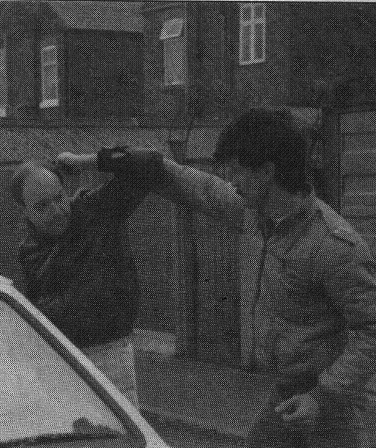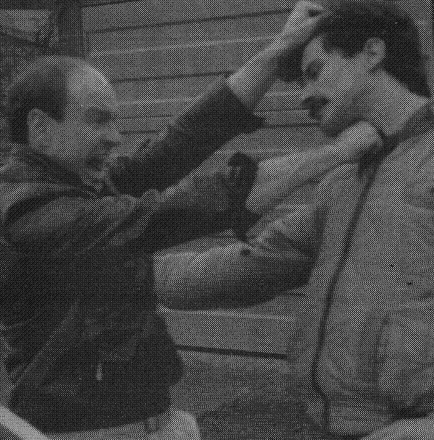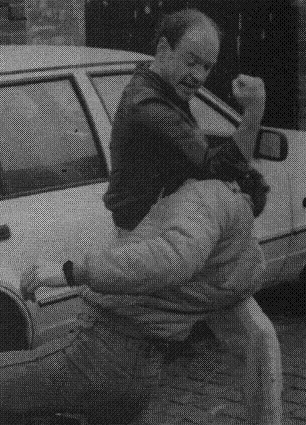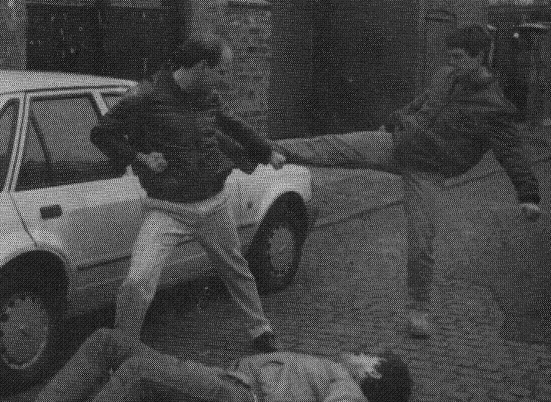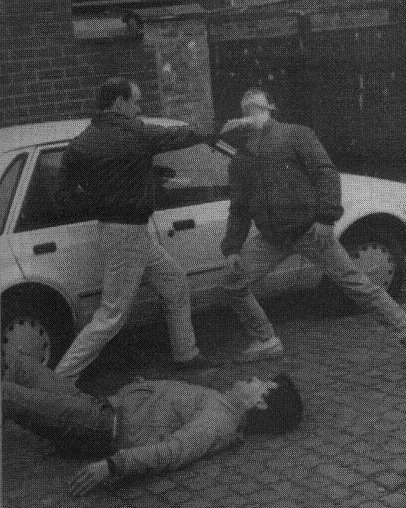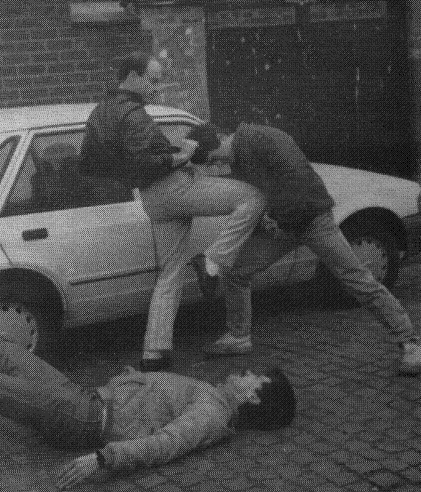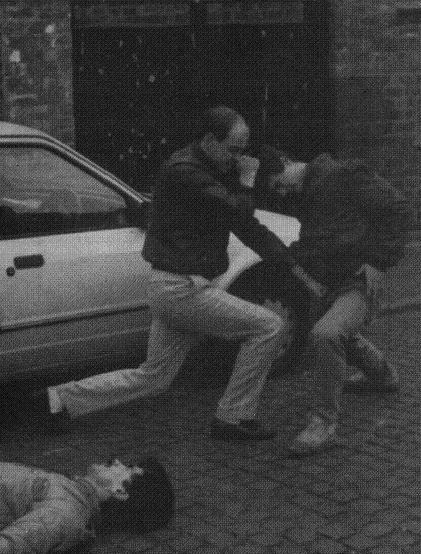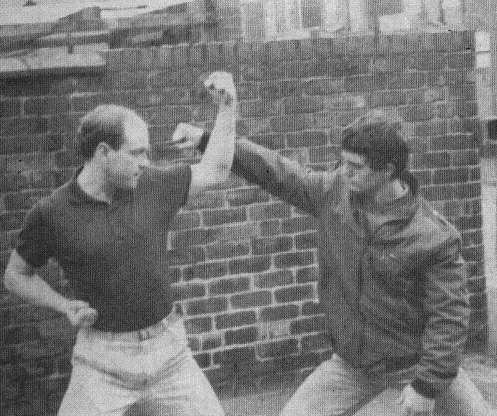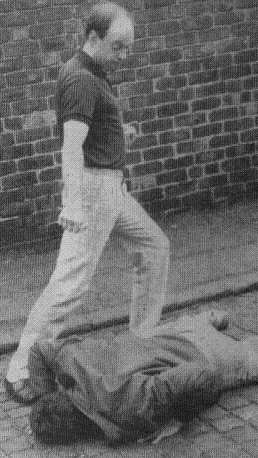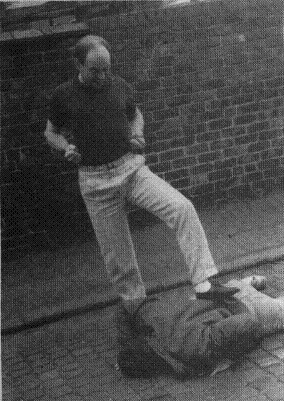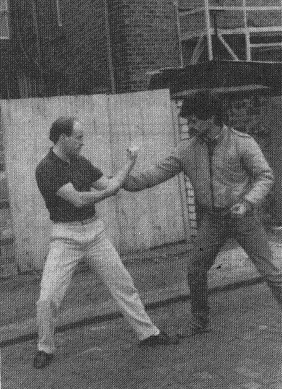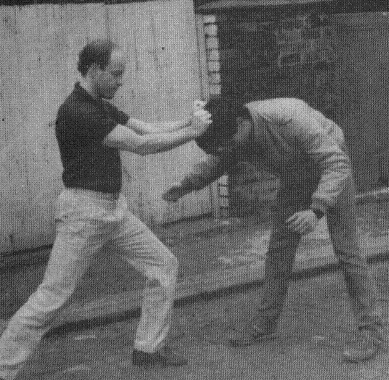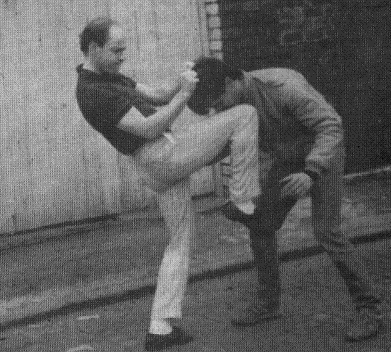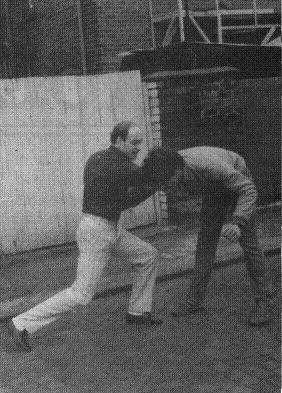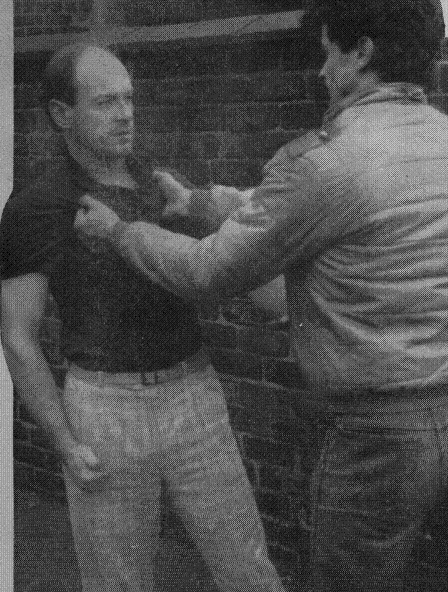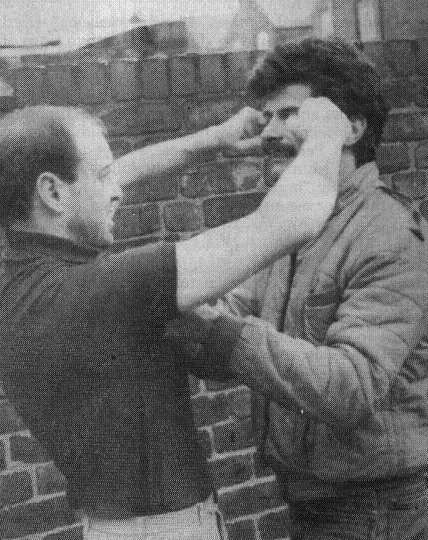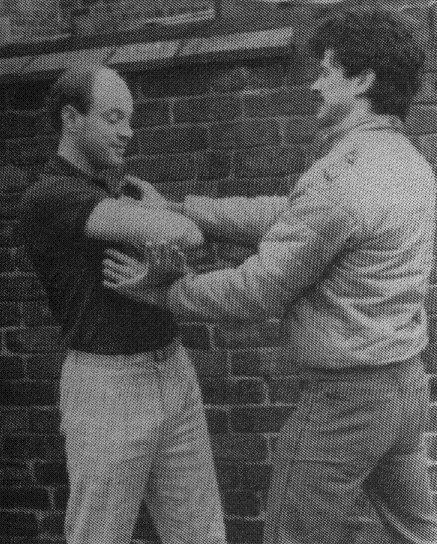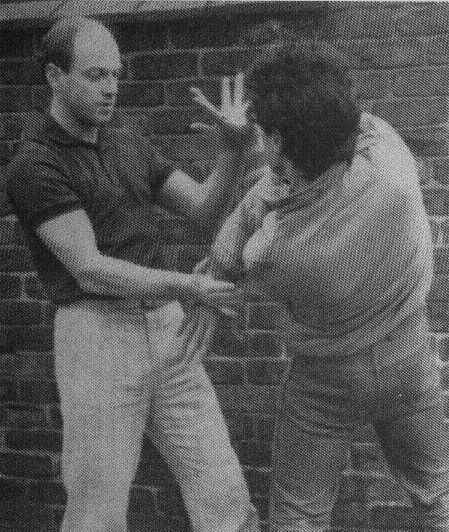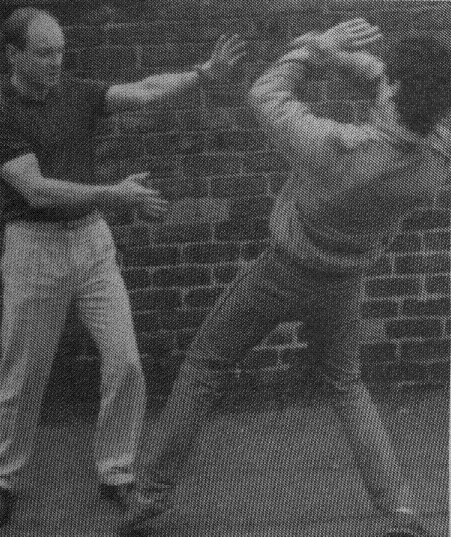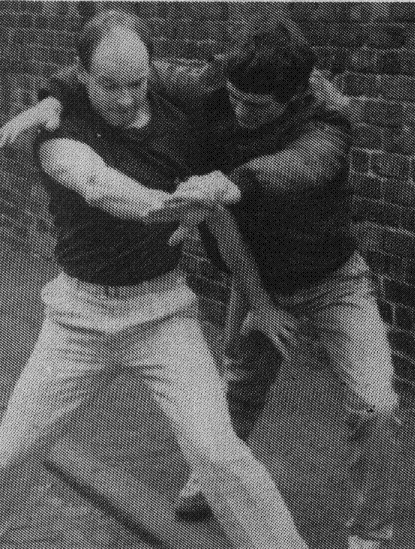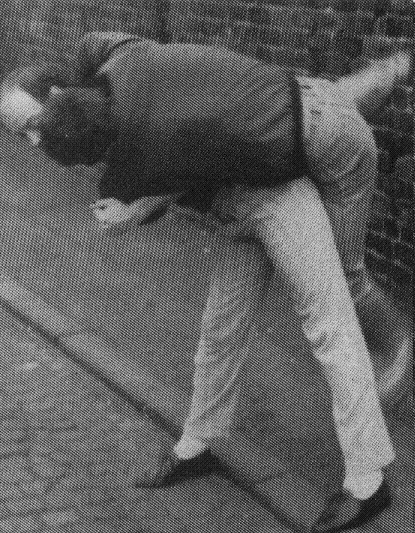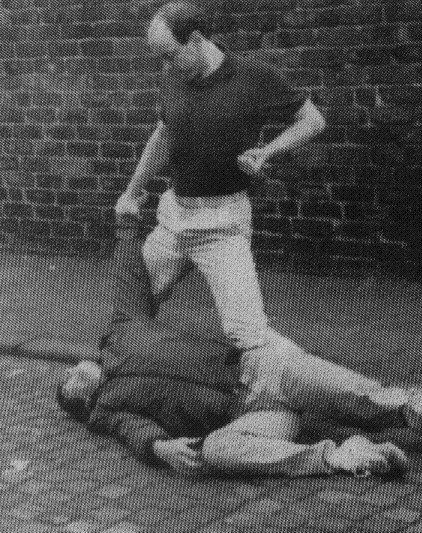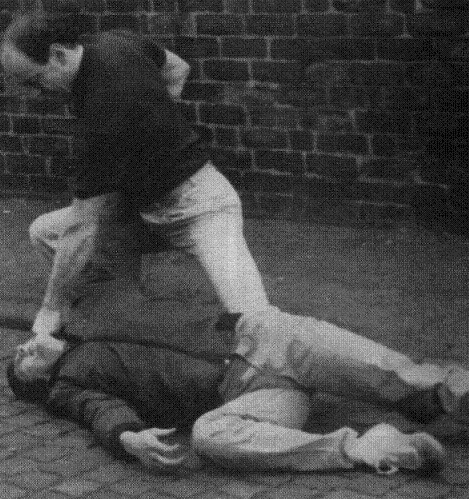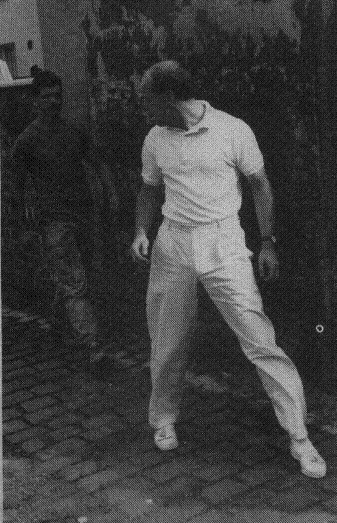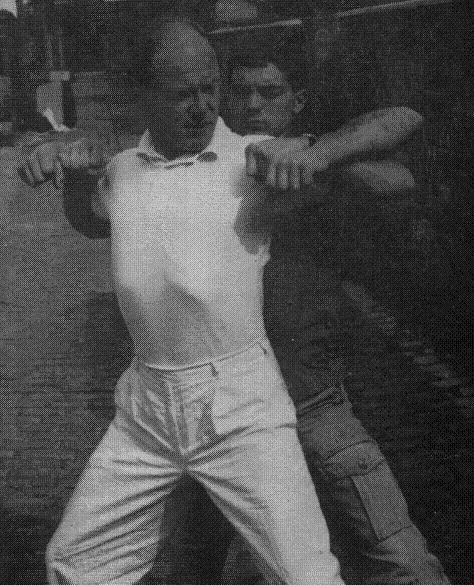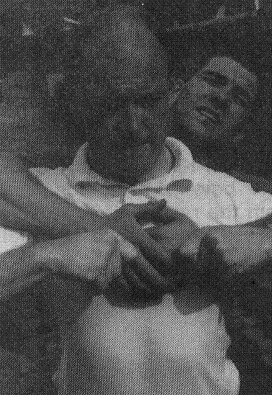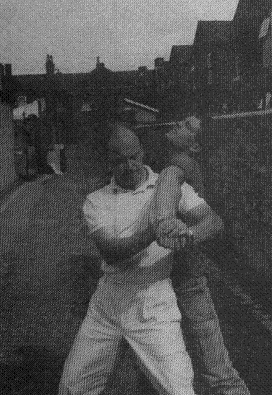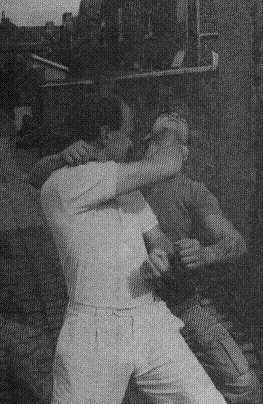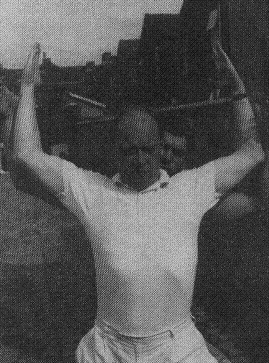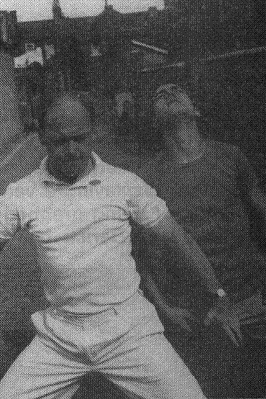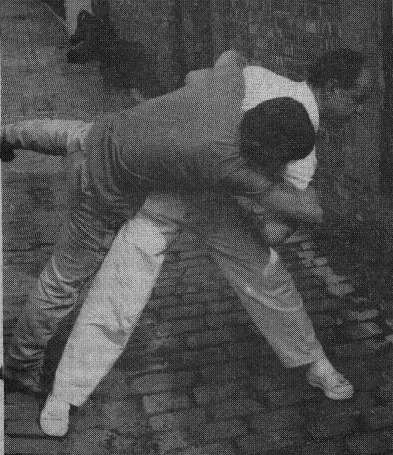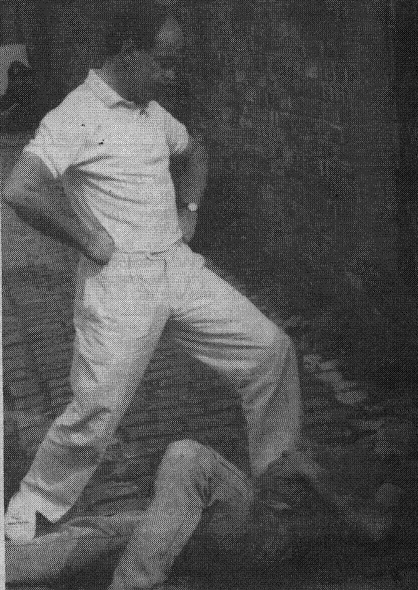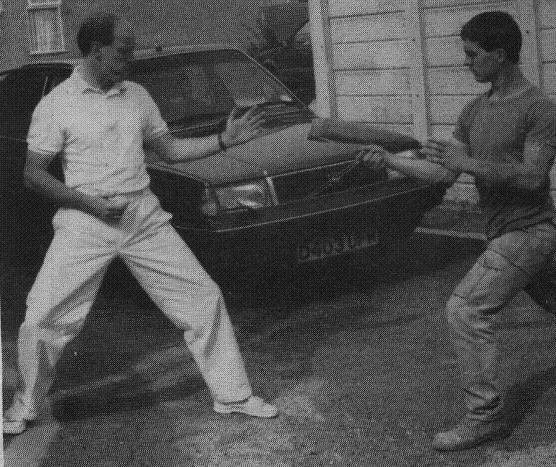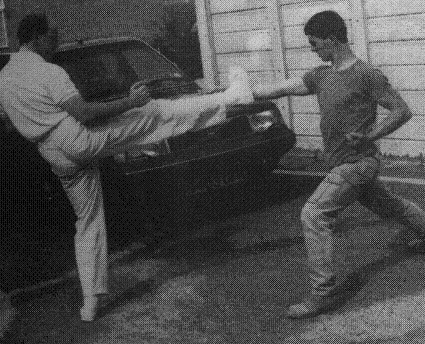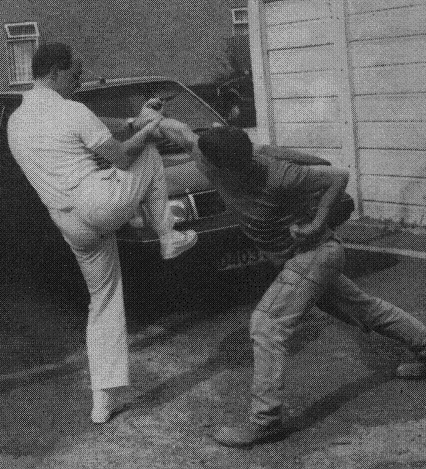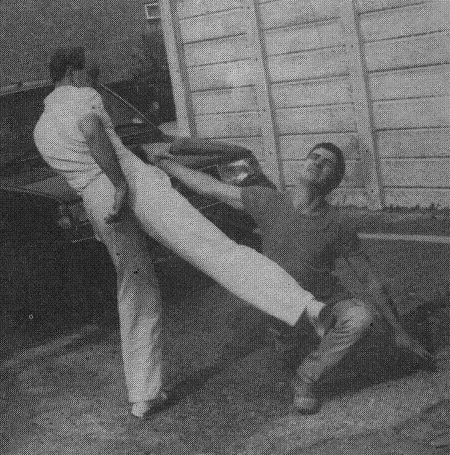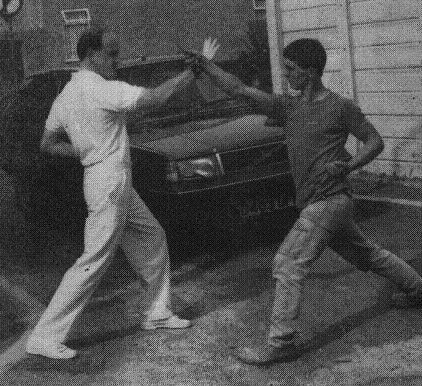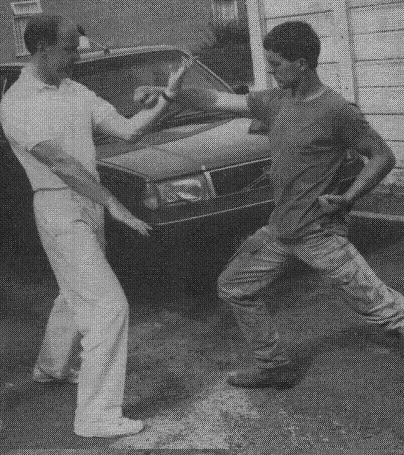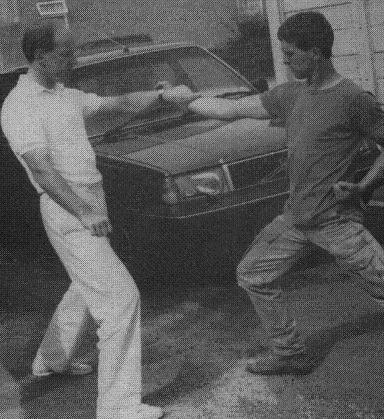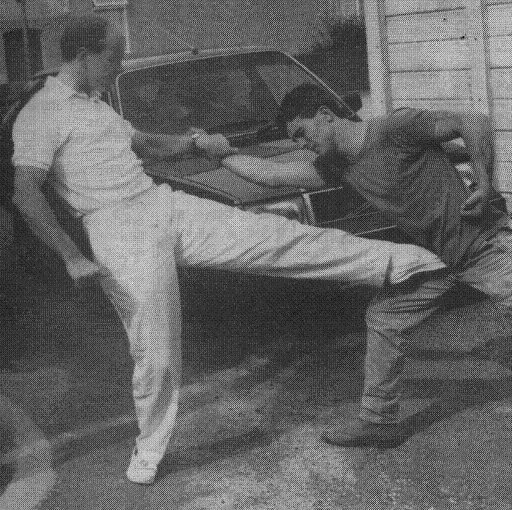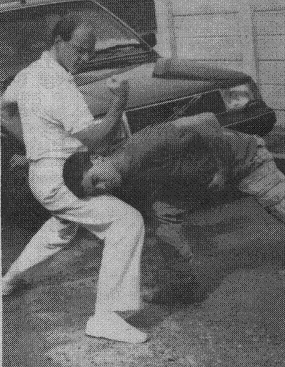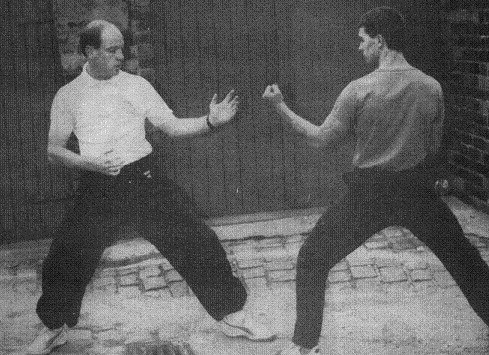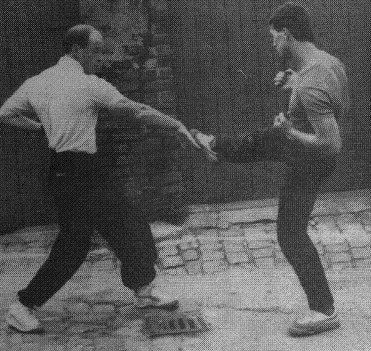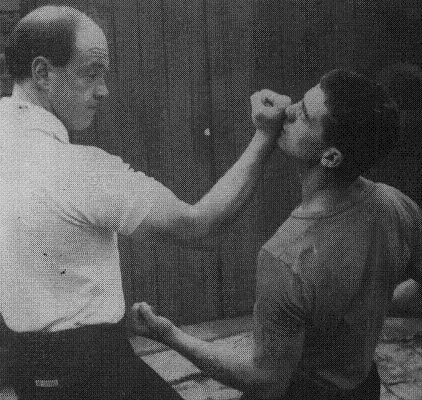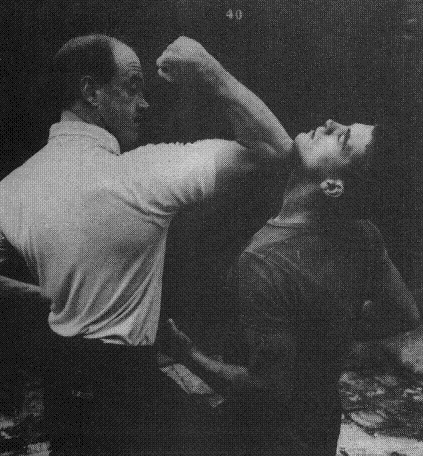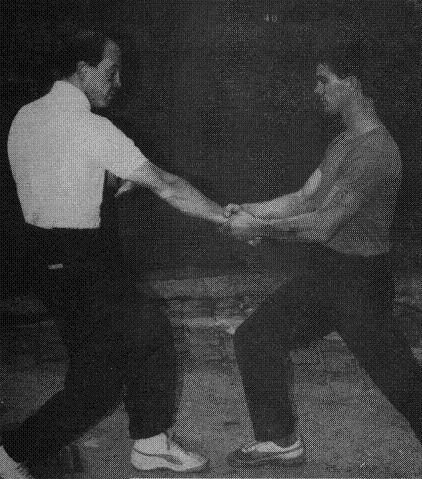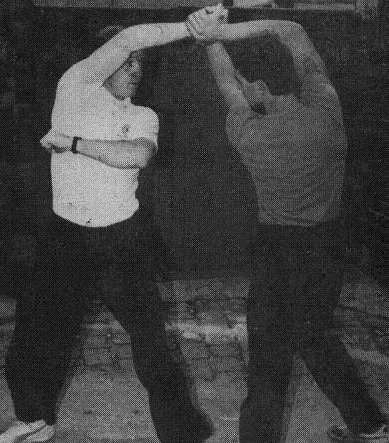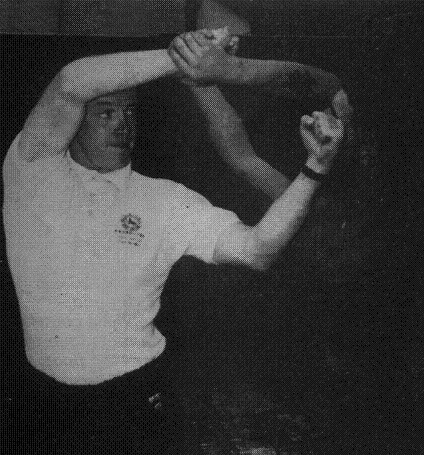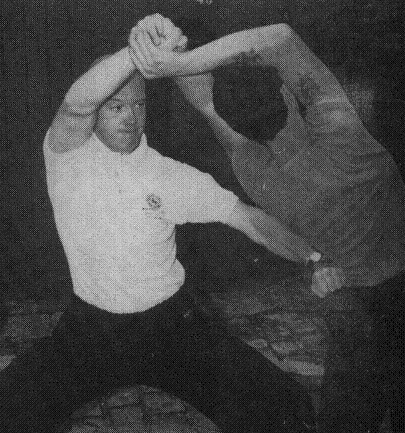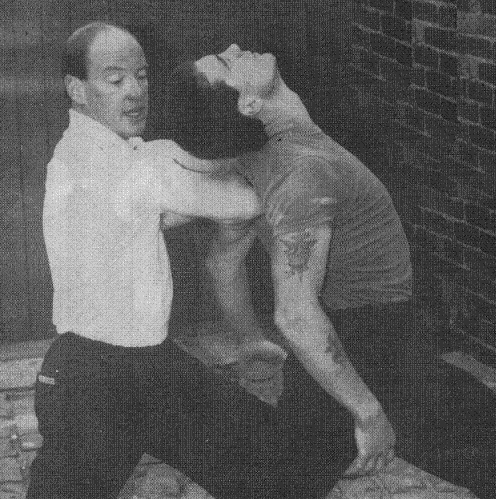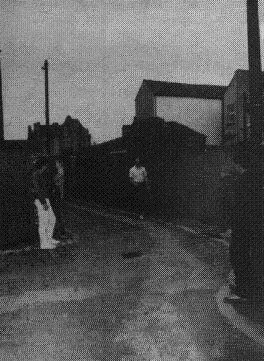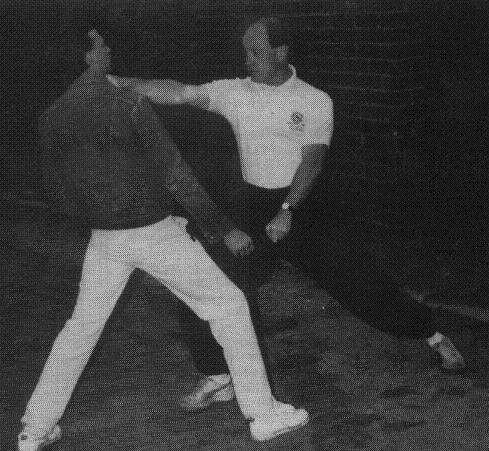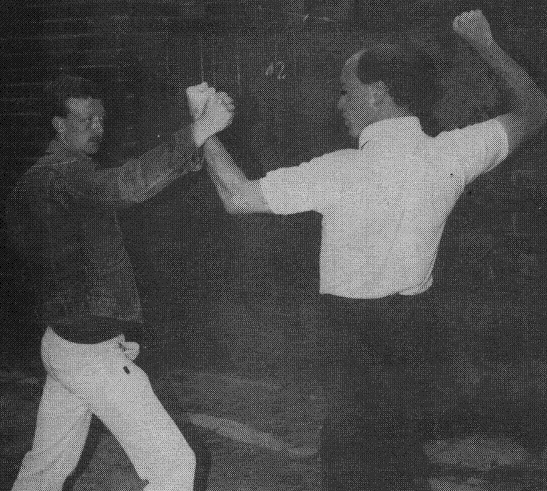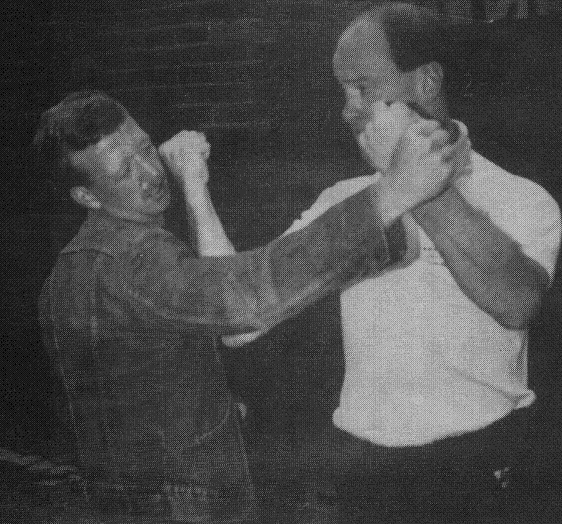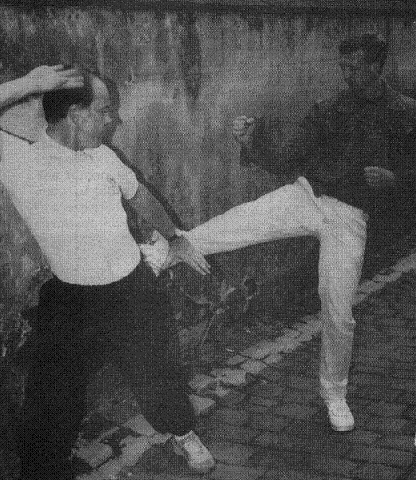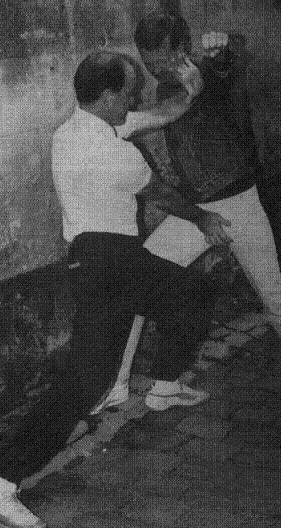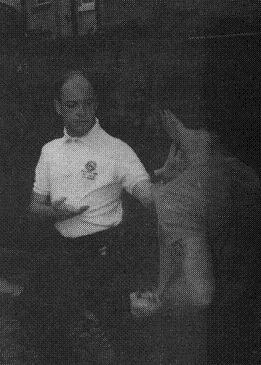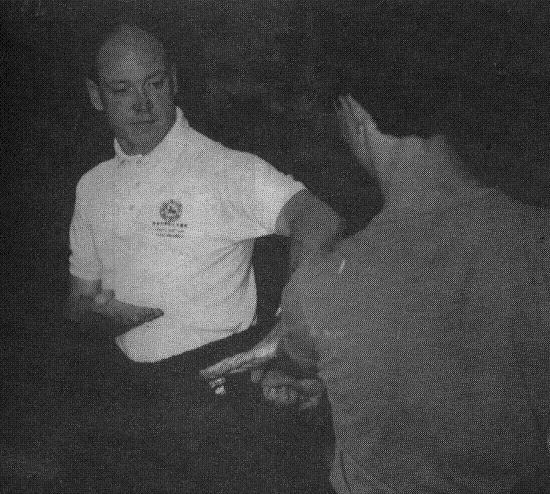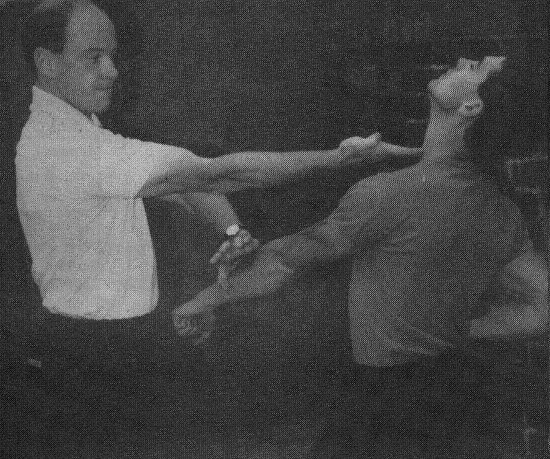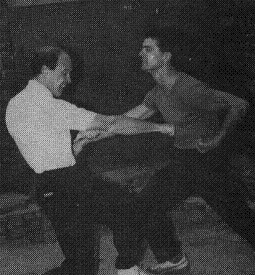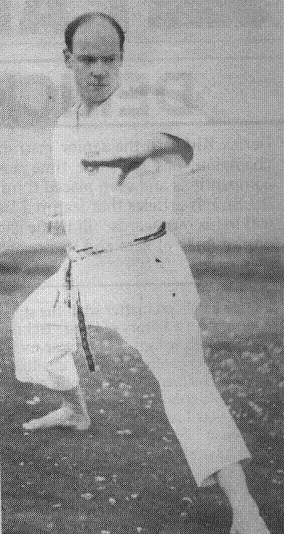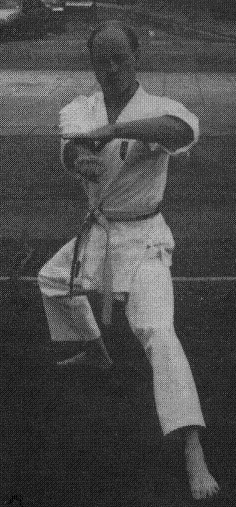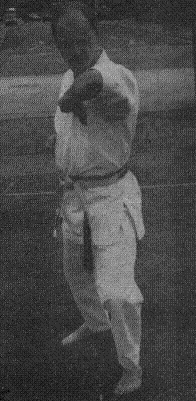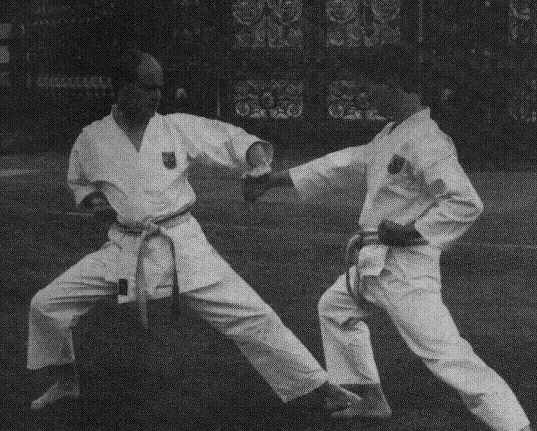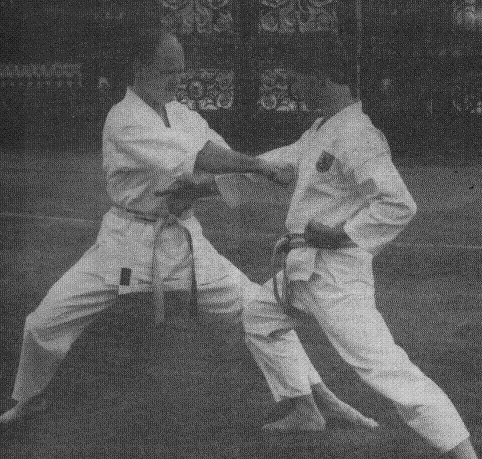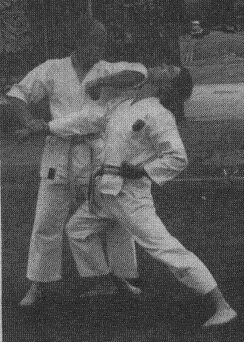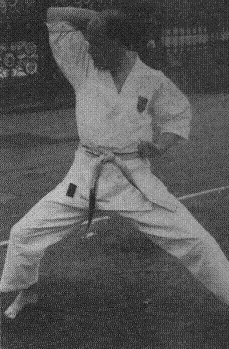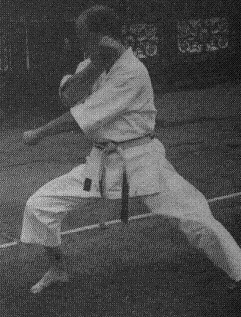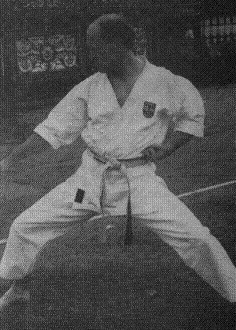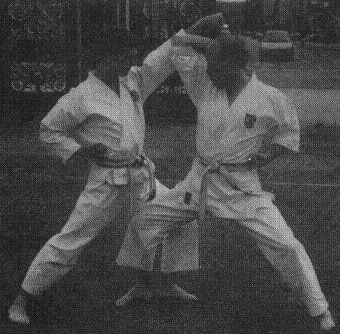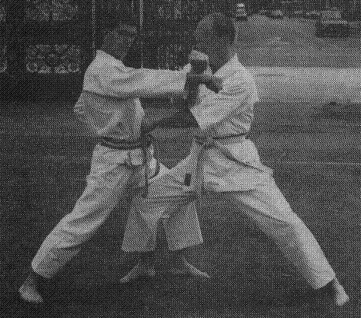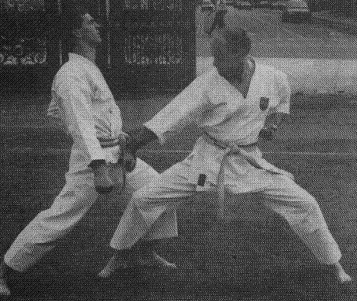"Coaching The SKU Way!" Official SKU Coaching Resource
First Published July 1987 Issue # 3 May 2001 SKU Quarterly Magazine
Shotokan in the Street
by Derick Kirkham

Shotokan in the streets is the title of a series of two videos that were produced by the Shotokan Karate Union in the 1980s that featured its director of coaching. Stills from the videos were successfully reproduced and serialised in The "Traditional Karate and Combat" magazines. The original purpose of the videos was not to be a mini course in self defence but was designed to raise the interest levels in the study of traditional shotokan karate kata bunkei & oyo; by highlighting that there are many little hidden workable gems that are nestled inside the moves of the traditional kata of shotokan karate system, and how that they can be utilised effectively for the purpose of self defence, if they are (applied) slightly adapted to suit a street situation.
The Shotokan Karate Union SKU teaches a Traditional Shotokan Karate system strictly as a Budo & Bujutsu art form. Our successful, tried and tested, Structured Coaching & Grading System does include the "faster, stronger, harder" approach to coaching for our Karate-ka when needed. But the SKU System goes way beyond that, because, as a group we focus our efforts and activities strictly upon the analysis of, the understanding of & the improvement of the factors that affect our ability to achieve higher technical standards of proficiency. This is Kaizen 改善, which is the continuous Improvement of ones performance in realistic, measurable and achievable stages. And we blend Kaizen 改善with the holistic approach of Shin-Tai-Waza 進体技. Which encompasses the coaching of the Karate-Kas’ Mind, Body and Technique.
The focus of our structured coaching & grading system is different in many ways from other mainstream organisations today, for example it is not influenced in any way by the aims of or the rules and regulations of competitive Sport Karate. We feel that the practice of and the adaptation of basic technique for the sole purpose of using that technique in a Sporting Karate context would also require one to change ones focus to suit the limiting rules and regulations of the game. This would be an un-necessary distraction away from the underpinning ethos of all of the SKU’s studies. We therefore deem the practice of technique for use in a Sporting Karate context as incompatable with the aims of the SKU.
Our structured syllabus revolves in the early grades around the understanding of and the achieving of “Good Form” and aiming for excellence in the execution of the principles of movement. The principles that are associated with the techniques (Waza) and the Kata of the SKU Shotokan Karate-do system.
Techniques are not practiced merely to score points to win a sporting match, because the SKU ethos behind the practice of all of our techniques is to achieve performance excellence in the execution of the techniques with focus strictly on “OYO”, which is the practical application of karate technique for the purpose of self defence. This aspect is taught from the beginning but plays a larger and larger role in the coaching and training of SKU students as they progress steadily through to the ranks to the senior grades. The SKU syllabus and system encourages the student to progress in every dimension and follows the relationship philosophy of Shu Ha Ri 守 破 離 througout.
Our system keeps alive the cultural and Traditional Budo values that are closely associated with Shotokan Karate-Do style. Specifically the values that were at the heart of what was taught by the styles Japanese founding fathers, We therefore, recognise the pioneering work done by the Japan Karate Association, the teachings of Masters Gichin & Yoshitaka Funakoshi, Masatoshi Nakayama, Hirokazu Kanazawa, Keinosuke Enoeda, Masao Kawasoe and others.
By practicing Shotokan Karate-Do in this way, purely as a Traditional Japanese Martial Art form, then we believe that the legacy that we will leave for future generations will be one where they can continue to appreciate the benefits of the Traditional Japanese Shotokan Karate-Do system, and therefore, the new generation of students will be enriched and reap greater long term benefits thereof.
This series of scenarios isolates techniques from various Traditional Japanese Shotokan kata and it puts them into a street setting, merely to stimulate the thought processes of Traditional Shotokan Karate students. Designed to accompany their physical training actions, those actions that are taken in the dojo. Another aim of the series of articles is that they are to generate an interest in understanding the kata a little better and a little deeper. Hopefully through a better understanding of the kata, then ones performance can only improve, especially if the important element of the ability to use visualisation in ones training is utilised. As it has previously been a neglected and in some cases a missing ingredient in ones kata training regime. Visualisation is important during practice because it has proven over the years to help a large group of students to push themselves onward to achieve a much higher standard of performance and therefore increase their lvels of enjoyment during their practices.
|
|
|
|
|
| Photo 1 This is a scenario where a lone individual is at risk, when they are getting into their car especially when it is parked off the main road. |
Photo 2 Using tate empi as a defence as seen in Nijushiho. The attacker, is using mawashi tsuki. |
Photo 3 The defender stretches out the arm that has just performed the tate empi to grab the hair, or the ear if the attacker is bald or has short hair, to perform jodan tsuki to the trachea. |
Photo 4 Continuing to pull the attacker sideways and downwards and perform otoshi empi to the carotid artery and jugular vein. |
|
|
|
|
|
| Photo 5 Ushiro gedan barai as seen in Enpi to the opponents front kick. |
Photo 6 Counter with jodan age tsuki. |
Photo 7 Grab the hair and perform hiza geri also in the same Enpi sequence. |
Photo 8 Finish this encounter with gedan tsuki to the symphis pubis. Whilst not performed in the kosa dachi as in Enpi, the net effect is the same. |
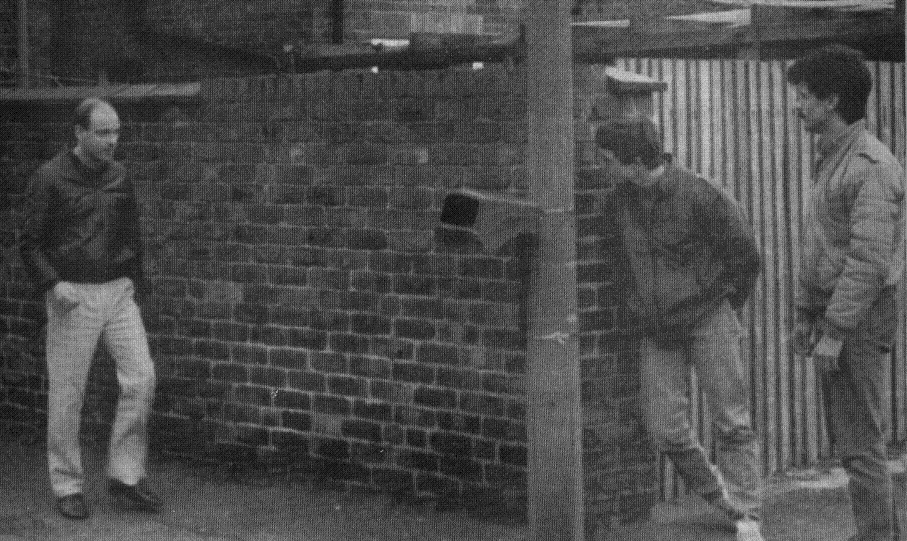 |
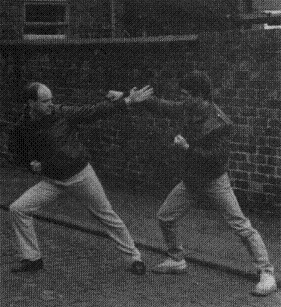 |
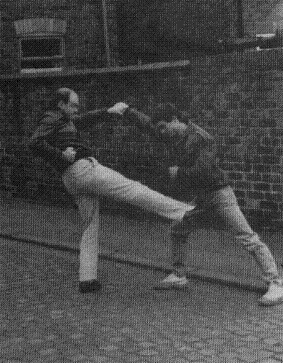 |
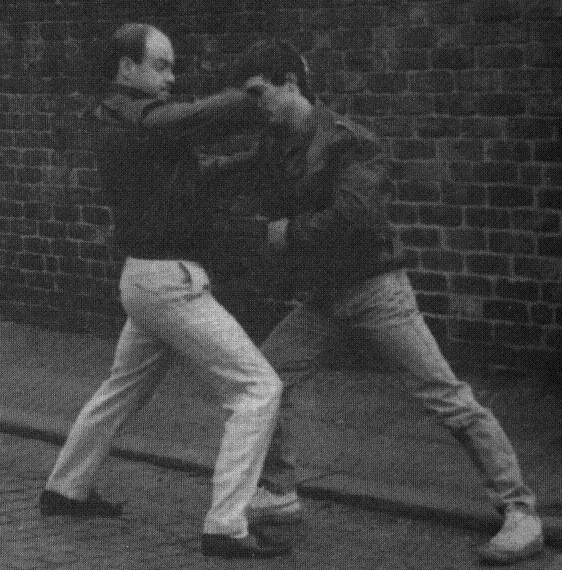 |
| Photo 1a This scenario the defender is on foot. When approaching a corner you should never take a close inside line as it hinders ones range of vision. |
Photo 2a Notice how the defender has stepped out to offer some distance allowing him to parry the punch with haishu uke as seen in Kanku sho. |
Photo 3a Maegeri to the groin not the usually associated mikatsuki geri after a haishu uke that is seen in many of the kata. |
Photo 4a However, the mawashi empi uchi as seen in Heian Godan, Bassai dai and others is the usual follow on technique. |
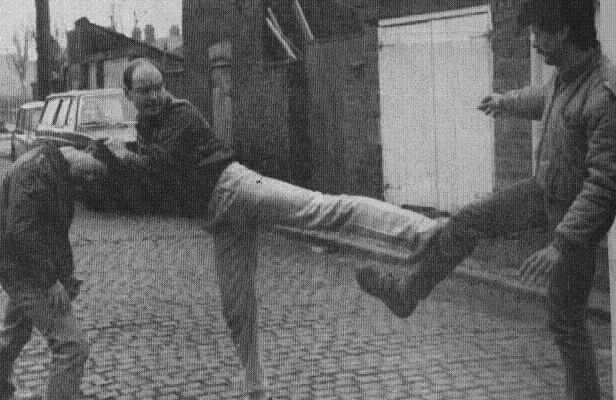 |
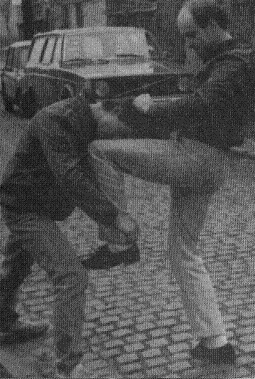 |
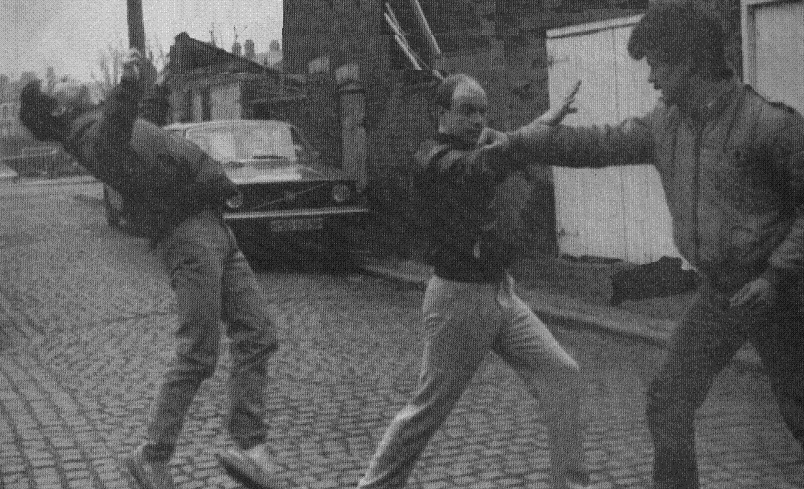 |
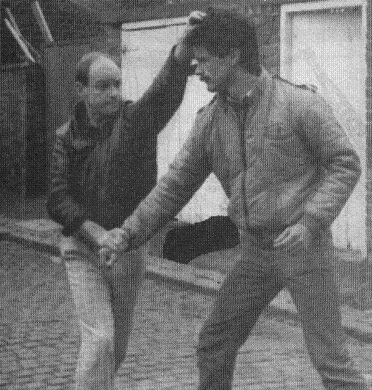 |
| Photo 5a Attacker 1 is momentarily stunned from the mawashi empi uchi which allows the time to halt a would be maegeri from attacker 2 by using a blocking yoko geri aimed at the opponents shin as in Bassai dai. |
Photo 6a With attacker 2 also momentarily stunned you are now able to finish off attacker 1 with the use of hiza geri as in Heian yondan. |
Photo 7a Attacker 2 throws a mawashi tsuki, stepping inside with tai sabaki and blocking jodan age shuto uke as in Bassai dai this allows you to grab and control them with tsukami uke. |
Photo 8a Pulling down his arm and grabbing the hair allows full control to pull him in a rotational manner. |
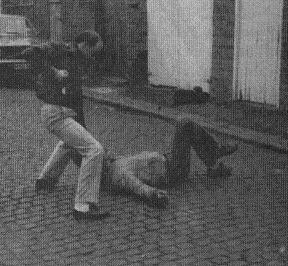 |
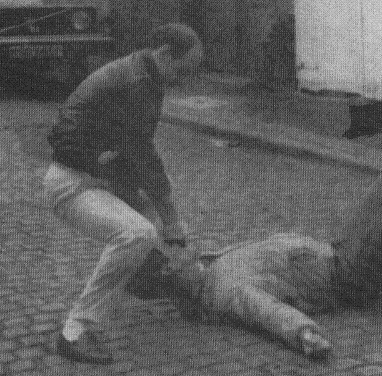 |
||
| Photo 9a Resulting in total destabilisation of the opponent. |
Photo 10a Follow up immediately with the decisive blow of otoshi tate tsuki. |
||
|
|
|
|
|
| Photo 1b The first move is jodan uchi uke but is inspired by the heiwan uke from the first sequence of Heian nidan. |
Photo 2b As is the counter attack of the ura tsuki, and it is assisted here with a hair grab and head pull. |
Photo 3b Take the punching hand and grab the head pulling the opponent to the ground leaving you in the gyaku gedan barai posture. |
Photo 4b Fumikomi is the decisive blow and aimed at the kidneys of the now face down attacker. |
|
|
|
|
|
| Photo 5b Heian yondan is the source of photos 5b, 6b, 7b. Morote uke is the initial defence. |
Photo 6b Shifting the body weight forward to perform the head grab. |
Photo 7b Pulling down the opponents head and simultaneously attacking with hiza geri. |
Photo 8b An additional gedan tsuki to the groin ends this scenario. |
|
|
|
|
|
| Photo 1c Double lapel grab is the defence scenario. |
Photo 2c Nakadaka ippon ken hassami tsuki as seen in Chinte but this time to a jodan not chudan target. |
Photo 3c Once stunned perform mawashi uke as in Nijushiho. |
Photo 4c Step forward and push the attacker away. |
|
|
|
||
| Photo 5c Now the opponent is in range for a follow on technique of choice such as a kick. |
|||
|
|
|
|
|
| Photo 6c An attempted grab from behind if foiled by side stepping in yori ashi and perform gedan shuto uchi to the groin. |
Photo 7c Grab the attacker as he stoops forward and perform ogoshi hip throw as implied in katas Heian sandan, & Gojushiho. |
Photo 8c Use an arm lever to control the attacker before delivering the final technique. |
Photo 9c Drop the body weight into your otoshi tsuki to deliver the decisive blow. |
|
|
|||
| Photo 1d This scenario offers four different options to the same grab from behind, the start position will be the same in all four options. |
|||
|
|
|
|
|
| Photo 2d Option 1 If you are alerted early enough of the grab then drop the bodyweight, open the chest and pull the arms apart as in the first move of Tekki nidan. |
Photo 3d Alternatively if you are caught totally unaware then use the double knuckle fist as seen in Hangetsu this secures a release, which is enough to launch your counter. |
Photo 4d Which this time is the arm lever over the shoulder as seen in Kanku dai and Gankaku. |
|
|
|
|
|
|
| Photo 5d Option 2 |
Photo 6d Again using the double knuckle fist. |
Photo 7d Then use yori ashi to the side allowing you to perform tsuki age the swinging punch over the shoulder as seen in Heian sandan. |
|
|
|
|
|
|
| Photo 8d Option 3 |
Photo 9d To secure the freeing action use kaishu ryo sho yama kamae, which is taken from Hangetsu. |
Photo 10d Deliver your counter with the gedan shuto uchi again from Hangetsu. |
|
|
|
|
|
|
| Photo 11d Option 4 |
Photo 12d Using the ogoshi major hip throw as implied in Gojushiho sho. |
Photo 13d You are now in the ideal position to deliver the decisive blow of choice. |
|
|
|
|
|
|
| Photo 1e This scenario offers three different options to a roundward knife attack or punch. The start position will be the same in all three options. |
|||
|
|
|
|
|
|
Photo 2e Uses Mikatsuki geri
from Heian godan, Bassai dai etc.. |
Photo 3e Secure a grip of the attacking hand and use Kinsetsu geri / Fumikiri geri taken from Basssai dai. |
Photo 4e The dislocation kick creates destabilisation which allows you to take control of the weapon. |
|
|
|
|
|
|
|
Photo 5e
|
Photo 6e As in the previous option secure a grip of the attacking hand and use Kinsetsu geri / Fumikiri geri taken from Basssai dai. |
Photo 7e The dislocation kick creates destabilisation which allows you to take control of the weapon. |
|
|
|
|
|
|
| Photo 8e Option 3 uses Uchi uke with an open hand as in Hangetsu. |
Photo 9e As in the previous option secure a grip of the attacking hand. |
Photo 10 e Counter with maegeri aimed at symphis pubis. |
Photo 11e Pull the attacker forward and deliver the decisive blow of otoshi empi uchi aimed at the jugular vein and carotid artery. |
|
|
|
|
|
| Photo 1f This scenario utilises techniques from several kata. |
Photo 2f Gedan gyaku uchi haito barai from Heian nidan against the opponents chudan maegeri. |
Photo 3f Move in close with uraken in kosa dachi as in Heian yondan. |
Photo 4f Follow on to deliver the decisive blow of tate empi as in Chinte. |
|
|
|
|
|
| Photo 5f The opponent grabs your arm, and the following moves were inspired by Kanku dai whilst individual moves can be seen in other kata. |
Photo 6f Step inwards to close the distance and elevate the grabbed arm. |
Photo 7f Use the opening technique from Heian nidan but use it as uraken not as haiwan uke. |
Photo 8f Perform tettsui uchi / wanto uchi creating muso kamae as in Sochin. |
|
|
|||
| Photo 9f Mawashi empi uchi seen in Heian godan, Tekki shodan, Bassai dai and others. |
|||
|
|
|
|
|
| Photo 1g This long range photo highlights the wisdom of never walking too close to a wall when approaching corners as it give one a wider range of vision. |
|||
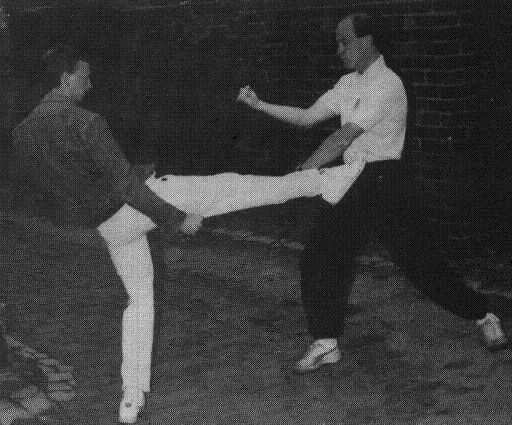 |
|
|
|
| Photo 2g Kosa uke as in Jion, blocks the attackers front kick. |
Photo 3g The none blocking hand is poised for the counter attack of kizami tsuki to the trachea. |
Photo 4g Hineri uke / Nagashi uke blocks Mawashi tsuki taken from Sochin. |
Photo 5g Immediately followed by Ura tsuki / Uraken uchi. |
|
|
|
|
|
| Photo 6g Gedan shuto uke from Heian yondan and Kanku dai blocks the maegeri attack. |
Photo 7g Simultaneously perform jodan Taisho nagashi uke and gedan taisho uchi similar to Heian godan. |
||
|
|
|
|
|
| Photo 8g Directly taken from Sochin Shuto uke. |
Photo 9g Osae uke. |
Photo 10g Shihon nukite. |
Photo 11g And an additional Gyaku tsuki to the solar plexus or sternum is the decisive blow. |
|
|
|
|
Nijushiho Sequence one |
|
|
|
|
|
| Osae uke | The Gyaku tsuki is slightly adapted to strike over the osae uke unlike in the kata where it appears under the osae uke. |
Likewise the Mae empi uchi it
is slightly
adapted here to strike over arm towards the chin of the attacker unlike
the usual application of using it underneath as a fulcrum for an arm
lever. |
|
|
|
|
|
Nijushiho Sequence two |
|
|
|
|
|
| Another slight adaptation to the usually taught application, in as much that the Tate empi is used as a block and not as a strike. |
Soto uke blocks the Gyaku tsuki. |
The Gedan barai here is aimed at the groin and is used as the decisive blow not as a block. |
|
Remember that the examples here are to stimulate thought and to highlight that with a slight adaptation to suit the arena of the street that kata do possess numerous workable self defence techniques. They are not intended as a substitute for qualified instruction in self defence.

